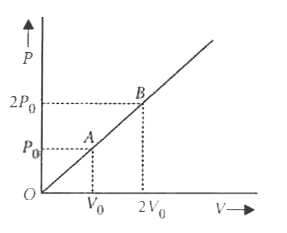2 moles of ideal monatomic gas is carried from a state (P0,V0) to a state (2P0,2V0) along a straight line path in a P- V diagram. The amount of heat absorbed by
3P0V0
92P0V0
6P0V0
32P0V0
The correct Answer is:c

Total work done for path AB ,
WAB = are under curve AB=P0V0+12P0V0=32P0V0
Change in internal energy for path AB
ΔUAB=nCvΔT (.∴ for monatomic gas, CV=32R)
∴ΔUAB=n32R(4P0V0nR−P0V0nR)
⇒ΔUAB=9P0V02
∴ The amount of heat absorbed by the gas in the process is ,
ΔQ=WAB+ΔUAB=32P0V0+92P0V0=6P0V0
Topper's Solved these Questions
- THERMODYNAMICSBOOK - MTG-WBJEECHAPTER - THERMODYNAMICSEXERCISE - WB JEE WORKOUT ( CATEGORY 3 : One or Mare than One Option Correct Type (2 Mark )
10 Videos
- SOLID STATE ELECTRONS BOOK - MTG-WBJEECHAPTER - SOLID STATE ELECTRONS EXERCISE - WB JEE Previous Years Questions (CATEGORY 1 : Single Option Correct Type)
15 Videos
- WAVE OPTICSBOOK - MTG-WBJEECHAPTER - WAVE OPTICSEXERCISE - WB JEE PREVIOUS YEARS QUESTION (MCQ.s)
9 Videos
Similar Questions
An ideal monatomic gas is at P0,V0. It is taken to final volume 2V0 when pressure is P0/2 in a process which is straight line on P−V diagram. Then

View SolutionAn ideal gas is taken from the state A (pressure p, volume V) to the state B (pressure p2, volume 2V) along a straight line path in the p-V diagram. Select the correct statement(s) from the following.
View Solution
Knowledge Check
One mole of a gas obeying the expantions P(V-b)=RT is made to expand from a state with (P1,V1) to a state with (P2,V2) along a process that by a straight line on a P-V diagram. Then the work given by:
A12(P2−V1)(V2+V1+2b)B12(P1+P2)(V2−V1)C12(P2−P1)(V2−V1)D12(P1+P2)(V2−V1+2b)An ideal gas taken from state A(P,V) to the state B(P/2,2V) along a straight path in PV diagram. Select the correct option(s).
AIn PT diagram path AB becomes a part of hyperbola.BWork done by the gas In the process A to B is more than the work done if the system were taken from A to B along an isotherm.CIn TV diagram,t he path AB becomes a part of parabola.Din going from A to B the temperature T of the gas first increases to a maximum value and then decreases.An ideal gas is taken form the state A(P,V) to the state B(P2,2V) along a straight line path in the P−V diagram.
Select the correct options
(i) The work done by the gas in the process A to B exceeds the work that would be done by it if the system were taken from A to B along the isotherm
(ii) In the T−V diagram, the path AB becomes part of a hyperbola
(iii) In the P−T diagram, the path AB becomes part of a hyperbola
(iv) In going from A to B, the temperature T of the first increases to maximum value and then decreasesA(i),(iii)B(ii),(iii)C(iii),(iv)D(i),(ii),(iv)
An ideal gas is taken from the state A (pressure p, volume V) to the state B (pressure p2, volume 2V) along a straight line path in the p-V diagram. Select the correct statement(s) from the following.
View SolutionAn ideal monatomic gas is at P0,V0. It is taken to final volume 2V0 when pressure is P0/2 in a process which is straight line on P−V diagram. Then

View SolutionAn ideal gas is taken from the state A (pressure P, volume V) to the state B (pressure P/2, volume 2V) along a straight line path in the P-V diagram. Select the wrong statement from the following:

View SolutionAn ideal gas is taken from the state A (pressure P, volume V) to the state B (pressure p/2, volume 2V) along a straight line path in the P-V diagram. Select the correct statement (s) from the following :
View SolutionAn ideal gas is taken from the state A (pressure p, volume V) to the state B (pressure p2, volume 2V) along a straight line path in the p-V diagram. Select the correct statement(s) from the following.
View Solution
